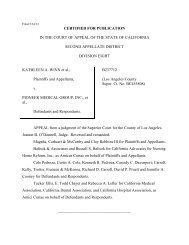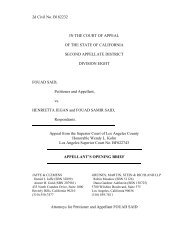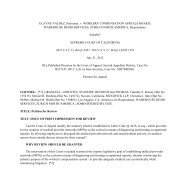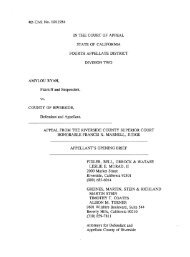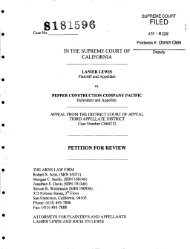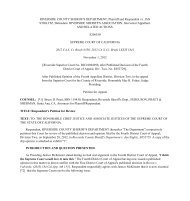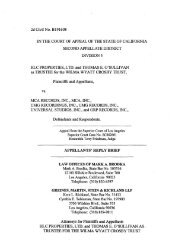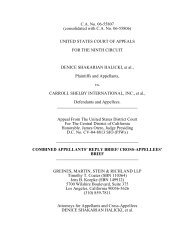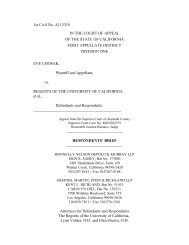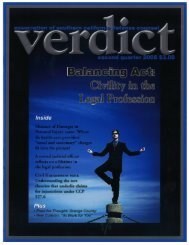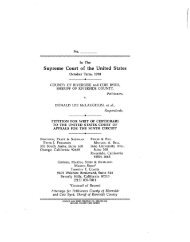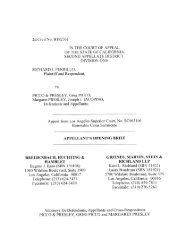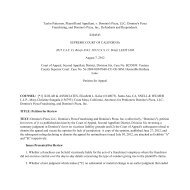Roosen v. Farrell Opinion - Greines, Martin, Stein & Richland LLP
Roosen v. Farrell Opinion - Greines, Martin, Stein & Richland LLP
Roosen v. Farrell Opinion - Greines, Martin, Stein & Richland LLP
Create successful ePaper yourself
Turn your PDF publications into a flip-book with our unique Google optimized e-Paper software.
Filed 8/27/10 <strong>Roosen</strong> v. <strong>Farrell</strong> CA2/1<br />
NOT TO BE PUBLISHED IN THE OFFICIAL REPORTS<br />
California Rules of Court, rule 8.1115(a), prohibits courts and parties from citing or relying on opinions not certified for<br />
publication or ordered published, except as specified by rule 8.1115(b). This opinion has not been certified for publication<br />
or ordered published for purposes of rule 8.1115.<br />
IN THE COURT OF APPEAL OF THE STATE OF CALIFORNIA<br />
SECOND APPELLATE DISTRICT<br />
DIVISION ONE<br />
VICTOR ROOSEN,<br />
Plaintiff and Appellant,<br />
v.<br />
B209873<br />
(Los Angeles County<br />
Super. Ct. No. BC386547)<br />
DOUGLAS J. FARRELL,<br />
Defendant and Respondent.<br />
APPEAL from orders of the Superior Court of Los Angeles County. Luis A.<br />
Lavin, Judge. Affirmed.<br />
Lisitsa Law Corporation and Yevgeniya Lisitsa for Plaintiff and Appellant.<br />
Richard D. Marks; <strong>Greines</strong>, <strong>Martin</strong>, <strong>Stein</strong> & <strong>Richland</strong>, Robin Meadow and Lara<br />
M. Krieger for Defendant and Respondent.<br />
_____
Plaintiff Victor <strong>Roosen</strong> appeals from an order striking his complaint for malicious<br />
prosecution against Attorney Douglas J. <strong>Farrell</strong> pursuant to <strong>Farrell</strong>‟s special motion to<br />
strike under Code of Civil Procedure section 425.16. 1 We affirm the order because<br />
<strong>Farrell</strong>‟s alleged conduct is within the ambit of section 425.16 and <strong>Roosen</strong> failed to<br />
provide evidence to establish a probability of prevailing on the merits of his malicious<br />
prosecution claim.<br />
BACKGROUND<br />
Victor <strong>Roosen</strong>, a real estate broker, worked with Sammy Ray Williams (Sammy),<br />
as administrator of the estate of decedent Willie Mae Williams, to sell a parcel of real<br />
property to Trustee Properties, LLC. Sammy claimed that he was related to Willie Mae.<br />
After Willie Mae‟s grandson, Keith Williams, discovered that Sammy had sold the<br />
property and a property belonging to the estate of his grandfather, Ardis Williams, Keith<br />
filed petitions in the probate court charging <strong>Roosen</strong>, Sammy, Trustee Properties, and<br />
others with fraud. <strong>Farrell</strong>, hired by Trustee Properties‟ title insurance company to defend<br />
Trustee Properties, filed cross-petitions against <strong>Roosen</strong>, Sammy, and others for<br />
declaratory relief and indemnity. Several months later, Trustee Properties obtained a new<br />
lawyer who filed a pleading striking <strong>Roosen</strong> as a respondent in Trustee Properties‟ crosspetitions.<br />
<strong>Roosen</strong> then brought this suit against <strong>Farrell</strong> for malicious prosecution.<br />
<strong>Farrell</strong> filed a special motion to strike the malicious prosecution complaint under<br />
section 425.16, arguing among other things that <strong>Farrell</strong> had probable cause to file and<br />
maintain the cross-petitions for declaratory relief and indemnity against <strong>Roosen</strong>. The<br />
motion was based on numerous documents filed in the probate matters as well as <strong>Farrell</strong>‟s<br />
declaration.<br />
1 Unspecified statutory references are to the Code of Civil Procedure.<br />
Section 425.16 is referred to as the anti-SLAPP statute. “SLAPP is an acronym<br />
for „strategic lawsuit against public participation.‟” (Simpson Strong-Tie Co., Inc. v.<br />
Gore (2010) 49 Cal.4th 12, 16, fn. 1.)<br />
2
A. Sammy Ray Williams’s Sales of the Real Properties to Trustee Properties<br />
Ardis and Willie Mae Williams, husband and wife, as joint tenants, owned a parcel<br />
of real property on 35th Place in Los Angeles. Willie Mae also was sole owner of<br />
another parcel of real property in Los Angeles on Manhattan Place (the Manhattan<br />
property). Willie Mae died in 2002. Ardis died in July 2005. In February 2006, Sammy,<br />
claiming to be the son of Willie Mae, filed in propria persona a petition for probate of the<br />
estate of Willie Mae (Estate of Willie Mae Williams (Super. Ct. Los Angeles County,<br />
No. BP096765)). On June 1, 2006, a court order appointed Sammy as the administrator<br />
of Willie Mae‟s estate, and on June 28, 2006, letters of administration were issued to<br />
Sammy.<br />
On June 29, 2006, Sammy, as administrator of Willie Mae‟s estate, sold the 35th<br />
Place and Manhattan properties to Trustee Properties. In connection with the sale of the<br />
35th Place property, Sammy recorded an affidavit of death of joint tenant, claiming that<br />
Ardis had died in 1999. In August 2006, Trustee Properties, by its “Member/Manager”<br />
David J. Behrend, conveyed the two properties to Marc A. Petrie. Petrie is <strong>Roosen</strong>‟s<br />
registered domestic partner.<br />
B. Probate Petitions of Keith Williams<br />
Meanwhile, on June 21, 2006, Keith Williams (Keith), the grandson of Willie Mae<br />
and Ardis Williams, filed two other proceedings to probate the estates of Willie Mae and<br />
Ardis Williams. (Estate of Willie Mae Williams (Super. Ct. Los Angeles County,<br />
No. BP098204) and Estate of Ardis Williams (Super. Ct. Los Angeles County,<br />
No. BP098203).) Keith was appointed the administrator of his grandparents‟ estates. On<br />
July 18, 2006, letters of administration were issued to Keith in the two probate matters.<br />
On August 18, 2006, Keith, as administrator, filed verified petitions in his two<br />
probate matters to determine title and require transfer of the 35th Place and Manhattan<br />
properties to the estates of Ardis and Willie Mae respectively, and for damages for fraud.<br />
The petitions alleged that Trustee Properties, Victor <strong>Roosen</strong>, David Behrend, and Marc<br />
A. Petrie were “acting in concert and are in some manner responsible for the filing of the<br />
Petition for Probate used by Sammy Ray Williams to obtain authority to transfer the<br />
3
properties to Trustee Properties, and are not bona fide purchasers for value.” Keith also<br />
alleged that Trustee Properties, <strong>Roosen</strong>, Behrend, Petrie, and Sammy “intentionally acted<br />
to deceive by perpetrating a fraud or causing a fraud to be perpetrated on this Court to<br />
deprive the lawful estates of their property by using Sammy Ray Williams to pose as an<br />
heir when in fact he was not, to obtain authority for these wrongful and unlawful transfers<br />
of property.”<br />
On December 15, 2006, the probate court consolidated Sammy‟s petition with<br />
Keith‟s petition involving Willie Mae‟s estate. Sammy resigned as administrator of<br />
Willie Mae‟s estate on December 18, 2006, and on December 19, 2006, the court<br />
confirmed Keith as the sole administrator of Willie Mae‟s estate.<br />
In December 2006 and January 2007, Keith filed first amended petitions (verified<br />
by Keith‟s attorney on Keith‟s behalf) alleging that <strong>Roosen</strong> induced Sammy to pose as<br />
the rightful heir of Willie Mae and prepared the petition that Sammy filed in the probate<br />
court. Further, Sammy, Trustee Properties, <strong>Roosen</strong>, Behrend, and Petrie conspired to<br />
damage the estates of Willie Mae and Ardis; they knew that Sammy was not related to<br />
Willie Mae Williams and Willie Mae had predeceased Ardis; and that the 35th Place<br />
property, sold by Sammy as the administrator of Willie Mae‟s estate, was not an asset of<br />
Willie Mae‟s estate, but an asset of Ardis‟s estate, as Ardis was the surviving joint tenant.<br />
With respect to the Manhattan property, Keith alleged that Sammy, Trustee Properties,<br />
<strong>Roosen</strong>, Petrie, and Behrend conspired to convert the property to themselves.<br />
C. Sammy’s Final Account and Report<br />
Pursuant to court order, Sammy, through an attorney, filed a verified first and final<br />
account and report as administrator of Willie Mae‟s estate in February 2007. Sammy‟s<br />
report contained his version of the circumstances of the sale of the two properties to<br />
Trustee Properties.<br />
According to Sammy‟s report, his father was Ardis L. Williams, who owned<br />
several parcels of real property in Los Angeles and Louisiana at the time of his death in<br />
1999. <strong>Roosen</strong>, a licensed realtor who specializes in tracing missing heirs and buying<br />
abandoned properties from them, contacted Sammy in January 2006 and asked if he was<br />
4
the son of “Ardis Williams.” Sammy answered that he was. <strong>Roosen</strong> informed Sammy<br />
that he was heir to the 35th Place property. <strong>Roosen</strong> offered to purchase it from Sammy‟s<br />
father‟s estate for $100,000, and also to arrange for, and pay the costs of, administering<br />
the probate estate for Sammy‟s father. Believing that the property had been owned by his<br />
father, Sammy agreed to sell the property. Sammy is legally blind and relied on<br />
<strong>Roosen</strong>‟s description of the sale document. <strong>Roosen</strong> guided Sammy‟s hand in signing the<br />
document.<br />
Sammy further declared that, a while later, <strong>Roosen</strong> informed him that <strong>Roosen</strong> had<br />
found another property belonging to his father and father‟s wife, Willie Mae, and a parcel<br />
of separate property belonging to Willie Mae, the Manhattan property. Sammy realized<br />
that <strong>Roosen</strong> thought that Willie Mae was the name of Sammy‟s mother. Sammy told<br />
<strong>Roosen</strong> that his mother‟s name was “„Lottie.‟” <strong>Roosen</strong> suggested that Willie Mae had to<br />
be related to Sammy and had to be Sammy‟s stepmother. According to Sammy, his<br />
father had been married several times, “once bigamously,” and had had several<br />
mistresses, so Sammy thought it plausible that Willie Mae was one of those women, as<br />
Sammy also had a half sister named “„Mae.‟” Knowing that his father had died in 1999,<br />
Sammy believed that Willie Mae had survived his father and that her estate had to be<br />
probated first as the surviving joint tenant. <strong>Roosen</strong> offered to buy the Manhattan<br />
property from Willie Mae‟s estate for $125,000, and Sammy agreed to sell it.<br />
In February 2006, <strong>Roosen</strong> requested that Sammy sign some documents, which<br />
Sammy believed were two probate purchase agreements for the sale of the 35th Place and<br />
Manhattan properties. <strong>Roosen</strong> again guided Sammy‟s hand in signing the agreements. In<br />
May 2006, <strong>Roosen</strong> arranged for Sammy to be represented by an attorney, Richard Grain,<br />
in connection with the sales of the properties.<br />
<strong>Roosen</strong> assigned his interests in the properties to Trustee Properties and thereafter<br />
escrow was opened and Sammy executed grant deeds conveying the two properties to<br />
Trustee Properties. The deeds conveying the properties to Trustee Properties were<br />
recorded on June 30, 2006. After escrow closed, the escrow company contacted Grain<br />
for instructions for distribution of the sale proceeds, as no estate bank account had been<br />
5
opened. No estate account had been opened by July 17, 2006, when Keith‟s attorney<br />
contacted Grain and informed him that Sammy was neither Ardis‟s nor Willie Mae‟s son,<br />
and that Ardis had survived Willie Mae. Sammy told Grain that Sammy had never held<br />
himself out as Willie Mae‟s son, but he believed that he was her stepson. Sammy<br />
claimed that he was surprised to learn that his probate petition named him as Willie<br />
Mae‟s son.<br />
According to Sammy, <strong>Roosen</strong> admitted to Grain that <strong>Roosen</strong> knew before<br />
Sammy‟s probate petition was filed that Sammy was not Willie Mae‟s son, but that<br />
<strong>Roosen</strong> thought that there was no difference between a son and a stepson.<br />
Attorneys for both Keith and Sammy requested that Trustee Properties reconvey<br />
the 35th Place and Manhattan properties, but Trustee Properties refused, asserting that it<br />
had good title. In August, Trustee Properties conveyed the properties to Petrie, the<br />
registered domestic partner of <strong>Roosen</strong>. Petrie also refused to reconvey the properties to<br />
Keith as the administrator of the estates of Ardis and Willie Mae. Sammy‟s report<br />
appraised the value of the two properties together at $667,150; the net proceeds from<br />
Sammy‟s sales of the properties being held in the escrow account were approximately<br />
$219,000.<br />
D. Trustee Properties’ Cross-petitions to Quiet Title<br />
In October 2006, <strong>Farrell</strong> was retained by Lawyers Title Insurance Company to<br />
defend Trustee Properties and Petrie with respect to Keith‟s claims that Sammy‟s deeds<br />
of the two properties to Trustee Properties were void. On behalf of Trustee Properties<br />
and Petrie, <strong>Farrell</strong> drafted cross-petitions to be filed in the probate matters for the estates<br />
of Ardis and Willie Mae. The cross-petitions, filed in April 2007, asserted that, if the<br />
facts as claimed by Sammy were true, Trustee Properties would be entitled to<br />
indemnification and damages from <strong>Roosen</strong> if a court ultimately found that <strong>Roosen</strong> was<br />
guilty of fraud or if a court found Trustee Properties liable for damages as a result of the<br />
fraud perpetrated by <strong>Roosen</strong>.<br />
Before <strong>Farrell</strong> filed the cross-petitions in April 2007, he read Sammy‟s verified<br />
report filed in February 2007. <strong>Farrell</strong> characterized Sammy‟s verified report as “a<br />
6
oadmap for the actions attributed to [<strong>Roosen</strong>]. In part, I relied upon the Report when I<br />
prepared and filed the verified Cross-Petition.” <strong>Farrell</strong> further declared that before he<br />
filed the verified cross-petitions on behalf of Petrie (on April 2, 2007) and Trustee<br />
Properties (on April 12, 2007), both Petrie and Behrend, the managing member of<br />
Trustee Properties, had each signed a verification of his cross-petition.<br />
In addition, <strong>Farrell</strong>‟s law office, through <strong>Farrell</strong>‟s partner, Robert Cipriano,<br />
(referred to as <strong>Farrell</strong>) had written correspondence with Behrend‟s personal attorneys,<br />
Payman Taheri and Y. Gina Lisitsa before filing the cross-petitions. <strong>Farrell</strong> wrote to<br />
them on March 30, 2007, that “the request by your client, David Behrend, that I eliminate<br />
any claims against Victor <strong>Roosen</strong> in the Cross-Petitions to be filed on behalf of Trustee<br />
Properties, LLC, because of „personality problems‟ and without further explanation,<br />
creates serious impediments to its defense in these probate matters because, as you know,<br />
Keith Williams has alleged, in his capacity as the Administrator of the Ardis Williams‟<br />
and Willie Mae Williams‟ estates, that Mr. <strong>Roosen</strong> arranged the sale of the two properties<br />
that are the subject of the above probate actions by Sammy Ray Williams, as<br />
Administrator of the Estate of Willie Mae Williams, to Trustee Properties, LLC, based on<br />
the false representations that Sammy Ray Williams was related to Willie Mae Williams.<br />
[] As you also know, Sammy Ray Williams has supported those allegations with<br />
verified pleadings wherein he has detailed how he was approached by Victor <strong>Roosen</strong> who<br />
handled all the details relating to the filing of the probate matter in which Sammy Ray<br />
Williams was wrongfully appointed as the Administrator of the Willie Mae Williams‟<br />
estate, and he also handled all details relating to sales of the subject properties to Trustee<br />
Properties based on the misrepresentations that Sammy Ray Williams was qualified to be<br />
appointed as a personal representative of Willie Mae Williams‟ estate with the power to<br />
sell the subject properties. [] If the court finds that such evidence is competent, it could<br />
[restore title to the properties to Keith] free of the lien of the All-Inclusive Deed of Trust<br />
in favor of Trustee Properties, and [order that Trustee Properties pay the estate twice the<br />
value of the properties], and a failure to name Victor <strong>Roosen</strong> as a party who must<br />
7
indemnify Trustee Properties for the losses it will suffer under those circumstances, could<br />
leave it without a remedy and means to recover those losses.”<br />
In an April 2, 2007 letter by Taheri to <strong>Farrell</strong>, Taheri claimed that “the only thing<br />
that supports your position in suing Mr. <strong>Roosen</strong> is the verified complaint of [Keith]<br />
Williams. However, in these proceedings, it has become perfectly clear that [Keith] is<br />
controlled by his handlers and does not possess an independent mind. [Keith] does not<br />
have any idea what occurred here other than the fact that [Sammy] tried to steal his<br />
money. . . . [] Mr. Petrie is the domestic registered partner of Mr. <strong>Roosen</strong>. For Mr.<br />
Petrie to allege fraud on the part of Mr. <strong>Roosen</strong> is not unlike me accusing my wife of<br />
fraud outside the marital home . . . . [] . . . [] Mr. <strong>Roosen</strong> did not commit any fraud<br />
here, irrespective of the false allegations made against him. Let me give it to you another<br />
way: suppose someone thinks of you as a bad man; and I know you not to be one.<br />
Would it be proper of me to verify a pleading based on the earlier of the assertions? I<br />
would think not and I would think it also inappropriate. [] Now speaking strategically:<br />
how is it going to look when Mr. Petrie has sworn out a verified petition against his<br />
registered domestic partner, how would it seem to a jury or to the judge. Similarly, how<br />
would it seem to a judge or jury for the Trustee Properties to sue someone who they do<br />
business with on an ongoing basis and who they have no independent reason in<br />
disbelieving.”<br />
On April 3, 2007, <strong>Farrell</strong> wrote back to Taheri and Lisitsa that <strong>Farrell</strong> was<br />
concerned not with Keith‟s verified complaint, but with Sammy’s declaration that <strong>Roosen</strong><br />
approached Sammy and orchestrated the sale of the properties. <strong>Farrell</strong> believed that it<br />
was “very unlikely” that the court would disregard Sammy‟s testimony. <strong>Farrell</strong> also<br />
stated that the cross-petitions filed on behalf of Trustee Properties did not state that the<br />
allegations made by Sammy and Keith were true, but only that if they are found to be<br />
true, Trustee properties would be entitled to indemnification and damages. <strong>Farrell</strong><br />
concluded that there was “nothing „malicious‟ about the allegations made in the crosspetitions<br />
prepared by this office, they are, to the contrary, asserted for the express<br />
8
purpose of preserving remedies that may provide Trustee Properties and Marc Petrie with<br />
what may be the only means of recouping the losses they may suffer in this matter.”<br />
Taheri responded to <strong>Farrell</strong> by letter of April 9, 2007, stating that “as a strategic<br />
move it makes no sense for Trustee Properties to sue Victor <strong>Roosen</strong>,” and that it<br />
“presents a picture of a fractured defense.” Taheri also wrote that neither Petrie nor<br />
Trustee Properties believed that <strong>Roosen</strong> was “a wrongdoer in this action,” and if the<br />
client “is telling us that <strong>Roosen</strong> is not responsible, who are we to second guess that<br />
proposition? [] In short, I know that you are trying in good faith to protect both Mr.<br />
Petrie and Trustee Properties LLC from harm that may result if the petitions are found<br />
adverse to them. However, you must also consider what happens if [Keith‟s assertions<br />
turn] out to be false and Mr. <strong>Roosen</strong> prevails.”<br />
On May 15, 2007, <strong>Farrell</strong> signed a substitution of attorney and on June 1, 2007,<br />
<strong>Farrell</strong> was substituted out of the proceedings as counsel for Trustee Properties. Lisitsa<br />
was substituted in as counsel for Trustee Properties.<br />
On June 8, 2007, Trustee Properties, through Lisitsa, filed supplemental crosspetitions<br />
striking <strong>Roosen</strong> as a cross-respondent.<br />
E. <strong>Roosen</strong>’s Malicious Prosecution Action and <strong>Farrell</strong>’s Special Motion to Strike<br />
<strong>Roosen</strong>, through Lisitsa, filed a complaint for malicious prosecution against<br />
<strong>Farrell</strong>. <strong>Roosen</strong> alleged that <strong>Farrell</strong> forced Trustee Properties to sign a verification of the<br />
cross-petitions even though Trustee Properties told <strong>Farrell</strong> that <strong>Roosen</strong> had done it no<br />
wrong, and that the cross-petitions were filed with malice and with the intent to harm<br />
<strong>Roosen</strong> for the benefit of Lawyer‟s Title Insurance Company, which had hired <strong>Farrell</strong>.<br />
Neither Petrie nor the cross-petition filed by Petrie is mentioned in the malicious<br />
prosecution complaint, so Farrrell‟s actions on behalf of Petrie are not at issue in this<br />
case.<br />
<strong>Farrell</strong> filed a special motion to strike the complaint on the grounds that the<br />
complaint fell within the purview of section 425.16 and that <strong>Roosen</strong> could not establish a<br />
probability of prevailing on his complaint because (1) the striking of <strong>Roosen</strong>‟s name from<br />
the cross-petitions does not constitute a favorable termination for purposes of a malicious<br />
9
prosecution action, (2) <strong>Farrell</strong> had probable cause to file and maintain the cross-petitions<br />
as a matter of law, and (3) <strong>Roosen</strong> could not establish that <strong>Farrell</strong> acted with malice in<br />
filing the cross-petitions. The motion was supported by <strong>Farrell</strong>‟s declaration and the<br />
probate pleadings, including Keith‟s verified petitions and Sammy‟s verified final<br />
account and report.<br />
In opposition to the motion, <strong>Roosen</strong> maintained that (1) <strong>Farrell</strong>‟s representation of<br />
Trustee Properties without its consent was illegal and unethical under Business and<br />
Professions Code sections 6068, subdivision (e)(1) and 6104, 2 taking <strong>Farrell</strong>‟s actions in<br />
filing the cross-petitions outside the protection of section 425.16; (2) the voluntary<br />
dismissal of <strong>Roosen</strong> from the cross-petition constituted a favorable termination on the<br />
merits; (3) <strong>Farrell</strong> lacked probable cause to file and maintain the cross-petitions; and<br />
(4) <strong>Farrell</strong> acted with malice.<br />
<strong>Roosen</strong> supported his opposition with his declaration and the declarations of<br />
Behrend, 3 Petrie, and Taheri. In reply, <strong>Farrell</strong> filed objections to portions of the<br />
declarations of <strong>Roosen</strong>, Petrie, and Behrend. The trial court sustained most of <strong>Farrell</strong>‟s<br />
objections. As <strong>Roosen</strong> fails on appeal to establish any error or abuse of discretion as to<br />
2 Business and Professions Code section 6068 provides: “It is the duty of an<br />
attorney to do all of the following: [] . . . [] (e)(1) To maintain inviolate the<br />
confidence, and at every peril to himself or herself to preserve the secrets, of his or her<br />
client.”<br />
Business and Professions Code section 6104 provides: “Corruptly or willfully and<br />
without authority appearing as attorney for a party to an action or proceeding constitutes<br />
a cause for disbarment or suspension.”<br />
3<br />
<strong>Farrell</strong> filed a motion to strike the entirety of Behrend‟s declaration from the<br />
appellate record because during the trial on the probate matters involving the estates of<br />
Willie Mae and Ardis Williams in July 2009, Behrend testified that it was not his<br />
signature on the declaration. Behrend also testified that he did not know whether he<br />
authorized anyone to sign his name to the declaration and had no explanation as to how a<br />
signature that was not his appeared on the declaration. <strong>Roosen</strong> filed opposition to the<br />
motion and <strong>Farrell</strong> filed a reply. We denied the motion to strike Behrend‟s declaration<br />
from the record.<br />
10
the trial court‟s evidentiary rulings, we consider only those portions of <strong>Roosen</strong>‟s evidence<br />
admitted by the trial court. 4<br />
<strong>Roosen</strong> declared that he was not guilty of the allegations made against him by<br />
Keith; Sammy has not filed any claims against <strong>Roosen</strong>. Being sued by Petrie and by<br />
Trustee Properties, “the company whom I have done my best for,” was so painful for<br />
<strong>Roosen</strong> that he moved to Pittsburg and discontinued his relationship with Trustee<br />
Properties.<br />
Behrend declared that he was not told by <strong>Farrell</strong> that by signing the verification for<br />
Trustee Properties he would be suing <strong>Roosen</strong>. When he realized what he had signed, he<br />
immediately ordered that <strong>Roosen</strong> not be named in any petition by Trustee Properties.<br />
Behrend never authorized <strong>Farrell</strong> to sue <strong>Roosen</strong>, and Behrend “never harbored any doubt<br />
that <strong>Roosen</strong> was and is innocent of any wrongdoing.”<br />
The trial court granted <strong>Farrell</strong>‟s motion to strike, finding that <strong>Roosen</strong> had not met<br />
his burden of showing a probability of prevailing on his malicious prosecution claim<br />
because the probate cross-petitions filed against <strong>Roosen</strong> by Trustee Properties were<br />
legally tenable and there was also insufficient evidence that <strong>Farrell</strong> filed and maintained<br />
the cross-petitions with malice.<br />
<strong>Roosen</strong> appealed from the order granting the special motion to strike and a<br />
subsequent award of attorney fees to <strong>Farrell</strong>.<br />
4 <strong>Roosen</strong>‟s opening brief challenges the trial court‟s evidentiary ruling in general<br />
but does not identify or discuss each piece of evidence proffered, <strong>Farrell</strong>‟s evidentiary<br />
objection(s), and why the trial court‟s ruling as to the specific item of evidence was<br />
erroneous. We conclude that <strong>Roosen</strong> has not met his burden of establishing any error or<br />
abuse of discretion with respect to the trial court‟s evidentiary rulings because his briefs<br />
do not contain “argument and citations to authority as to why the trial court‟s evidentiary<br />
rulings were wrong.” (Villanueva v. City of Colton (2008) 160 Cal.App.4th 1188, 1198.)<br />
“We are not required to search the record to ascertain whether it contains support for<br />
[<strong>Roosen</strong>‟s] contentions.” (Mansell v. Board of Administration (1994) 30 Cal.App.4th<br />
539, 545.) Accordingly, in reviewing the ruling on the special motion to strike, we do not<br />
consider the evidence excluded by the trial court.<br />
11
DISCUSSION<br />
A ruling on a special motion to strike is reviewed de novo. (Cabral v. <strong>Martin</strong>s<br />
(2009) 177 Cal.App.4th 471, 478 (Cabral).) “The anti-SLAPP law [section 425.16]<br />
involves a two-step process for determining whether a claim is subject to being stricken.<br />
In the first step, the moving defendant is required to make a prima facie showing the<br />
plaintiff‟s action is subject to section 425.16, by showing the defendant‟s challenged acts<br />
were taken in furtherance of constitutional rights of petition or free speech in connection<br />
with a public issue, as defined by the statute.” (Wang v. Wal-Mart Real Estate Business<br />
Trust (2007) 153 Cal.App.4th 790, 800.) Once the defendant meets this burden, the<br />
burden shifts to the plaintiff to demonstrate the probability that he will prevail on the<br />
claim. (Freeman v. Schack (2007) 154 Cal.App.4th 719, 726.) The plaintiff must<br />
demonstrate that the complaint is both legally sufficient and supported by a prima facie<br />
showing of facts to sustain a favorable judgment if the evidence favorable to plaintiff is<br />
credited. (Taus v. Loftus (2007) 40 Cal.4th 683, 713–714.)<br />
A. Protected Activity Under Section 425.16<br />
Section 425.16, subdivision (b)(1), provides in pertinent part: “A cause of action<br />
against a person arising from any act of that person in furtherance of the person‟s right of<br />
petition or free speech under the United States Constitution or the California Constitution<br />
in connection with a public issue shall be subject to a special motion to strike, unless the<br />
court determines that the plaintiff has established that there is a probability that the<br />
plaintiff will prevail on the claim.”<br />
A malicious prosecution action qualifies for protection under section 425.16<br />
because filing a lawsuit is an exercise of a party‟s constitutional right of petition and is<br />
thus subject to the anti-SLAPP statute. (Sycamore Ridge Apartments LLC v. Naumann<br />
(2007) 157 Cal.App.4th 1385, 1398; see also Rusheen v. Cohen (2006) 37 Cal.4th 1048,<br />
1056 [filing and prosecution of a civil action is communicative conduct protected by anti-<br />
SLAPP statute].)<br />
<strong>Roosen</strong> maintains that <strong>Farrell</strong>‟s filing of the cross-petitions in the underlying<br />
probate matters is not protected conduct under section 425.16 because <strong>Farrell</strong> did not<br />
12
have the consent and authorization of his client Trustee Properties. <strong>Roosen</strong> argues that<br />
<strong>Farrell</strong>‟s actions violated the ethical rules and statutes governing attorneys and were<br />
“illegal,” so as to come within the illegality exclusion of Flatley v. Mauro (2006) 39<br />
Cal.4th 299 (Flatley). As explained below, the alleged or purported breach by <strong>Farrell</strong> of<br />
duties to Trustee Properties is not the sort of illegal conduct that triggers the Flatley<br />
exclusion. Further, <strong>Roosen</strong>, a stranger to the attorney-client relationship between <strong>Farrell</strong><br />
and Trustee Properties, lacks standing to assert the issue of any purported breach of<br />
duties by <strong>Farrell</strong> to Trustee Properties.<br />
In Flatley, “the California Supreme Court held that „a defendant whose assertedly<br />
protected speech or petitioning activity was illegal as a matter of law, and therefore<br />
unprotected by constitutional guarantees of free speech and petition, cannot use the anti-<br />
SLAPP statute to strike the plaintiff‟s complaint.‟ The court therefore concluded that<br />
„communications [which] constituted criminal extortion as a matter of law and, as such,<br />
were unprotected by constitutional guarantees of free speech or petition,‟ were not<br />
protected by the anti-SLAPP statute. ([Flatley, supra, 39 Cal.4th at p. 305].) The court<br />
made clear, however, that its holding was limited to „the specific and extreme<br />
circumstances of this case,‟ in which the assertedly protected communications, as a<br />
matter of law, fell outside the ambit of protected speech. [Citation.]” (Cabral, supra,<br />
177 Cal.App.4th at p. 480.)<br />
Flatley‟s illegality exclusion is limited to the circumstances where “the defendant<br />
concedes, or the evidence conclusively establishes, that the assertedly protected speech or<br />
petition activity was illegal as a matter of law.” (Flatley, supra, 39 Cal.4th at p. 320.)<br />
“If, however, a factual dispute exists about the legitimacy of the defendant‟s conduct, it<br />
cannot be resolved within the first step but must be raised by the plaintiff in connection<br />
with the plaintiff‟s burden to show a probability of prevailing on the merits.” (Id. at<br />
p. 316.) Accordingly, the illegality exception applies only if the defendant concedes, or<br />
the evidence conclusively establishes, that the conduct was illegal as a matter of law.<br />
(Cabral, supra, 177 Cal.App.4th at p. 482.) The illegality exception does not apply<br />
“where the legality of [an attorney‟s] litigation activities is a matter of considerable<br />
13
dispute.” (Kashian v. Harriman (2002) 98 Cal.App.4th 892, 910; id. at p. 920 [dispute<br />
concerned whether attorney‟s communications were protected by litigation privilege;<br />
court held that communications did not fall outside privilege simply because they were<br />
alleged to be fraudulent, perjurious, unethical, or illegal].)<br />
A defendant‟s protected speech or petitioning activity will be found to be illegal as<br />
a matter of law only under narrow circumstances and in “rare cases.” (Flatley, supra, 39<br />
Cal.4th at p. 320.) Thus, courts have applied an illegality exclusion where the conduct at<br />
issue involved violence, vandalism, or harassment (Lam v. Ngo (2001) 91 Cal.App.4th<br />
832, 851, fn. 12 [slashing tires, accosting restaurant patrons, vandalism]; Novartis<br />
Vaccines & Diagnostics, Inc. v. Stop Huntingdon Animal Cruelty USA, Inc. (2006) 143<br />
Cal.App.4th 1284, 1289–1291, 1296 [detonating explosive devices, trespass, harassment<br />
of employees at biomedical testing laboratory]), or laundering campaign money (Paul for<br />
Council v. Hanyecz (2001) 85 Cal.App.4th 1356, 1363, 1365–1367 (Paul)).<br />
Division Eight of this district has interpreted the word “„illegal‟” in Flatley to<br />
mean “criminal, and not merely violative of a statute.” (Mendoza v. ADP Screening &<br />
Selection Services, Inc. (2010) 182 Cal.App.4th 1644, 1654 (Mendoza).) “[A] reading of<br />
Flatley to push any statutory violation outside the reach of the anti-SLAPP statute would<br />
greatly weaken the constitutional interests which the statute is designed to protect. As<br />
[the defendant] correctly observes, a plaintiff‟s complaint always alleges a defendant<br />
engaged in illegal conduct in that it violated some common law standard of conduct or<br />
statutory prohibition, giving rise to liability, and we decline to give plaintiffs a tool for<br />
avoiding the application of the anti-SLAPP statute merely by showing any statutory<br />
violation.” (Mendoza, at p. 1654.)<br />
And <strong>Roosen</strong> fails to bring to our attention any case where a non-client (<strong>Roosen</strong><br />
was never <strong>Farrell</strong>‟s client) has been successful in establishing that an attorney‟s noncriminal<br />
litigation conduct fell outside the scope of the anti-SLAPP statute. On the other<br />
hand, several cases have affirmed orders granting attorneys‟ special motions to strike in<br />
that situation.<br />
14
In Cabral, a former wife‟s action against her former husband‟s attorney was held<br />
to have been properly dismissed under section 425.16 because the attorney‟s activities in<br />
helping the husband evade a child support judgment “were neither inherently criminal nor<br />
otherwise outside the scope of normal, routine legal services. Even if the attorney<br />
respondents‟ actions had the effect of defeating or forestalling [the ex-wife‟s] ability to<br />
execute her judgment for child support, thereby (according to [her]) violating the child<br />
support evasion statute, this is not the kind of illegality involved in Flatley . . . .”<br />
(Cabral, supra, 177 Cal.App.4th at p. 481.)<br />
In Seltzer v. Barnes (2010) 182 Cal.App.4th 953 (Seltzer), the Court of Appeal<br />
reversed an order denying an attorney‟s special motion to strike a fraud action and held<br />
that the motion should have been granted because there was a factual dispute as to<br />
whether the attorney, Barnes, engaged in unlawful settlement negotiations, thus<br />
precluding application of the Flatley exclusion.<br />
Seltzer was involved in a dispute with her homeowners association and tendered a<br />
cross-complaint against her to Allstate, her insurer under a homeowners policy. Allstate<br />
hired an attorney, Reynolds, to defend Seltzer on the cross-complaint, subject to a<br />
reservation of rights, taking the position that some of the claims against Seltzer were not<br />
covered by her policy. Barnes represented Allstate in negotiating a settlement of the<br />
covered claims by the homeowners association against Seltzer.<br />
Seltzer thereafter brought an action against Barnes for fraud and intentional<br />
infliction of emotional distress, alleging that Barnes colluded with counsel for the<br />
homeowners association to dismiss the covered claims so as to reconfigure the pleadings<br />
to attempt to eliminate coverage and Allstate‟s financial obligations to her. The trial<br />
court denied Barnes‟s special motion to strike, but the Court of Appeal reversed and<br />
directed the trial court on remand to grant the motion. The court stated that Seltzer‟s<br />
“brief on appeal includes several poorly developed arguments that the settlement<br />
negotiations were unlawful, but she fails to demonstrate the absence of relevant factual<br />
disputes.” (Seltzer, supra, 182 Cal.App.4th at p. 965.) The court also pointed out that<br />
Barnes represented Allstate, not Seltzer, and that Barnes‟s “negotiations with the<br />
15
Association did constitute petitioning activity on behalf of Allstate, which had ultimate<br />
authority over settlement of the covered claims” (id. at p. 968), and that Barnes‟s “role<br />
and the basis for his asserted liability was his negotiation of the agreement, which is<br />
conduct within the scope of section 425.16” (id. at p. 968, fn. 11).<br />
The Flatley exclusion was held not to apply to an attorney‟s violation of California<br />
Rules of Court, rule 1.20, in failing to redact certain personal information from an<br />
opposing party‟s credit reports before filing them in court. (G.R. v. Intelligator (2010)<br />
185 Cal.App.4th 606 (G.R.).) Even though the attorney in G.R. admitted the rule<br />
violation, the court found the reasoning in Cabral persuasive in holding that the rule<br />
violation “is not the type of criminal activity addressed in either Flatley, supra, 39<br />
Cal.4th 299 or Paul, supra, 85 Cal.App.4th 1356.” (G.R., supra, 185 Cal.App.4th at<br />
p. 616.)<br />
We apply the reasoning of Flatley, Cabral, Mendoza, Seltzer, and G.R. to<br />
conclude that the illegality exclusion does not apply to <strong>Farrell</strong>‟s alleged breaches of<br />
ethical rules or statutes governing attorneys.<br />
In addition, there is no evidence to support <strong>Roosen</strong>‟s accusation that <strong>Farrell</strong>, by<br />
virtue of his having been hired by Lawyer‟s Title, had an interest adverse to Trustee<br />
Properties, and that <strong>Farrell</strong> violated various ethical rules and statutes. An attorney<br />
retained by an insurer to represent an insured owes fiduciary duties to both the insurer<br />
and insured. (Long v. Century Indemnity Co. (2008) 163 Cal.App.4th 1460, 1468.) “In<br />
this „usual tripartite relationship existing between insurer, insured and counsel, there is a<br />
single, common interest shared among them. Dual representation by counsel is beneficial<br />
since the shared goal of minimizing or eliminating liability to a third party is the same.‟<br />
[Citation.]” (Ibid.)<br />
There is no evidence that the filing of the cross-petitions against <strong>Roosen</strong> was not<br />
consistent with Trustee Properties‟s best interest, notwithstanding the unexplained and<br />
unsupported belief of its manager, Behrend, that <strong>Roosen</strong> did nothing wrong. If the trier<br />
of fact believed Sammy‟s version of the events, Trustee Properties may not have had<br />
good title to the properties, and it would have been entitled to seek indemnity from<br />
16
Sammy and <strong>Roosen</strong>. Behrend‟s bare expression of opinion that <strong>Roosen</strong> did nothing<br />
wrong is insufficient to establish a conflict of interest between Trustee Properties and<br />
Lawyer‟s Title. In sum, the record does not contain evidence that “conclusively<br />
establishes” illegality, as required by Flatley. Nor do the unsupported allegations of<br />
illegality in <strong>Roosen</strong>‟s briefs meet the requirements of Flatley.<br />
Another problem with <strong>Roosen</strong>‟s attempt to apply the Flatley illegality exclusion in<br />
this case is that <strong>Roosen</strong> does not have standing to assert the purported illegality. The<br />
alleged illegality involves <strong>Farrell</strong>‟s purported malpractice or breaches of duties running<br />
from <strong>Farrell</strong> to his client, Trustee Properties. <strong>Roosen</strong> was never <strong>Farrell</strong>‟s client. Causes<br />
of action for attorney malpractice or professional negligence are not assignable in<br />
California as a matter of public policy. (Baum v. Duckor, Spradling & Metzger (1999) 72<br />
Cal.App.4th 54, 65–67.) Such claims are not assignable because of the public policies<br />
implicated by the unique quality of legal services, the personal nature of the attorney‟s<br />
duty to the client, and the confidentiality of the attorney-client relationship. (Fireman’s<br />
Fund Ins. Co. v. McDonald, Hecht & Solberg (1994) 30 Cal.App.4th 1373, 1379.)<br />
Permitting <strong>Roosen</strong> to assert claims belonging not to <strong>Roosen</strong>, but to Trustee<br />
Properties, would place <strong>Farrell</strong> in a conflict of interest with his former client. <strong>Farrell</strong><br />
would be in the untenable position of having to defend himself from <strong>Roosen</strong>‟s charges of<br />
breaches of duty to Trustee Properties without revealing privileged client<br />
communications. The same public policies which militate against assignment of claims<br />
for legal malpractice militate against permitting <strong>Roosen</strong> to assert his claims of illegality.<br />
For all of the foregoing reasons, we conclude that <strong>Farrell</strong>‟s alleged actions<br />
constitute protected activity under section 425.16. We turn to the issue of whether<br />
<strong>Roosen</strong> met his burden of showing a probability of prevailing on his claim for malicious<br />
prosecution.<br />
B. Probability of Success on Claim for Malicious Prosecution<br />
“To establish a cause of action for malicious prosecution, a plaintiff must<br />
demonstrate that the prior action (1) was initiated by or at the direction of the defendant<br />
and legally terminated in the plaintiff‟s favor, (2) was brought without probable cause,<br />
17
and (3) was initiated with malice.” (Siebel v. Mittlesteadt (2007) 41 Cal.4th 735, 740.)<br />
“„A litigant will lack probable cause for his action either if he relies upon facts<br />
which he has no reasonable cause to believe to be true, or if he seeks recovery upon a<br />
legal theory which is untenable under the facts known to him.‟” (Soukup v. Law Offices<br />
of Herbert Hafif (2006) 39 Cal.4th 260, 292.) “If undisputed facts in the record do<br />
establish an objectively reasonable basis for bringing the underlying action, the existence<br />
of other, allegedly disputed facts is immaterial,” and probable cause is established.<br />
(Sangster v. Paetkau (1998) 68 Cal.App.4th 151, 167.)<br />
“The attorney‟s obligation is to represent his client honorably and ethically, and he<br />
may, without being guilty of malicious prosecution, vigorously pursue litigation in which<br />
he is unsure of whether his client or the client‟s adversary is truthful, so long as that issue<br />
is genuinely in doubt. Indeed, a lawyer is ethically precluded from asserting his personal<br />
belief in the justice of his client‟s cause. [Citations.] The existence of evidence contrary<br />
to the position taken by an attorney in litigation does not of itself support the inference of<br />
lack of honest belief in the tenability of the cause prosecuted by him.” (Tool Research &<br />
Engineering Corp. v. Henigson (1975) 46 Cal.App.3d 675, 684, disapproved on another<br />
ground in Sheldon Appel Co. v. Albert & Oliker (1989) 47 Cal.3d 863, 882–883.)<br />
<strong>Roosen</strong> fails to explain why the facts known to <strong>Farrell</strong>, including Sammy‟s and<br />
Keith‟s pleadings, fail to show probable cause to file and prosecute the cross-petitions<br />
against him for indemnity and declaratory relief. Sammy‟s pleading unequivocally<br />
implicated <strong>Roosen</strong> in the fraudulent scheme. Behrend‟s bare assertions that he did not<br />
want Trustee Properties to sue <strong>Roosen</strong> and that <strong>Roosen</strong> did nothing wrong are insufficient<br />
to show that <strong>Farrell</strong>‟s giving of credit to Sammy‟s version of events was not objectively<br />
reasonable. In other words, given the genuine dispute of the facts known to <strong>Farrell</strong>,<br />
<strong>Roosen</strong> has not shown that it was objectively unreasonable for <strong>Farrell</strong> to file the crosspetitions<br />
against <strong>Roosen</strong>. <strong>Roosen</strong> thus fails to make a prima facie showing as to the<br />
element of lack of probable cause.<br />
We also conclude that <strong>Roosen</strong> also fails to provide any evidence to make a prima<br />
facie showing with respect to the element of malice. “Malice may not only consist of ill<br />
18
will or hostility toward the malicious prosecution plaintiff, but may also result where the<br />
prior suit was „instituted primarily for an improper purpose.‟” (Paulus v. Bob Lynch<br />
Ford, Inc. (2006) 139 Cal.App.4th 659, 675.)<br />
Behrend‟s attorney wrote to <strong>Farrell</strong>, “I know that you are trying in good faith to<br />
protect both Mr. Petrie and Trustee Properties, LLC from harm that may result if<br />
[Keith‟s] petitions are found adverse to them.” We agree with Behrend‟s attorney that<br />
the record shows only <strong>Farrell</strong>‟s good faith and not any malice.<br />
As <strong>Roosen</strong> makes no independent argument challenging the award of attorney fees<br />
to <strong>Farrell</strong>, we also affirm that order.<br />
DISPOSITION<br />
The orders granting the special motion to strike and awarding Douglas <strong>Farrell</strong><br />
attorney fees are affirmed. <strong>Farrell</strong> is entitled to his costs on appeal.<br />
NOT TO BE PUBLISHED.<br />
We concur:<br />
MALLANO, P. J.<br />
ROTHSCHILD, J.<br />
CHANEY, J.<br />
19



